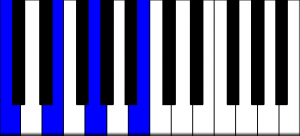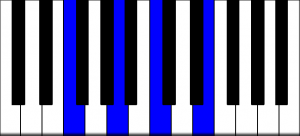Major Seventh Chords appear a lot in jazz as well, because they appear on the scale degrees I and IV of the major scale. The I major seventh chord is the home base to which all resolutions lead, the most common one being the 2 – 5 – 1 chord progression.
These chords are major chords which also include the major seventh of the respective key, thus consisting of the root, major third, fifth (the major triad) and major seventh. You can find the major seventh by moving down one half step from the root. In the key of C the major seventh is B (two half steps down from C), in the key of F it is E and in the key of G it is F# and so on. Major seventh chords are written as major 7, maj7 or ∆7.

Major Seventh Chords (with the seventh marked in blue)



The interval of the major seventh sounds dissonant on its own, but within the chord it produces a rather sweet quality. This sweet sound is also at the heart of the famous Gymnopédies by the French avant-garde pianist and composer Eric Satie. The major seventh chord is used a lot in other musical styles as well.
Play the following example to get an idea of the sweet major seventh quality. The progression simply moves from Cmaj7 to Fmaj7 and Gmaj7 where it rests for a second bar with some arpeggiated chord tones in the right hand.


